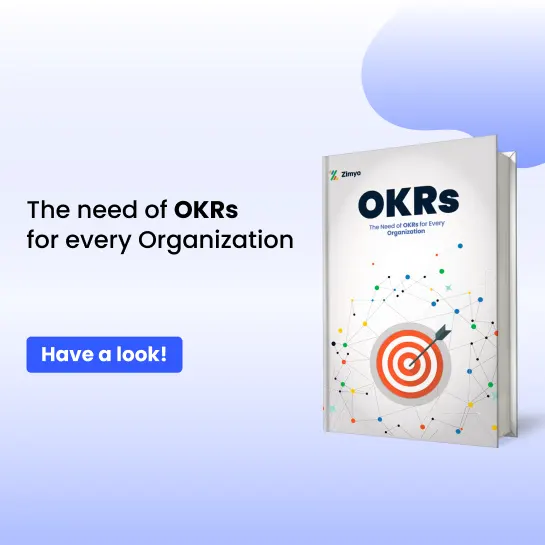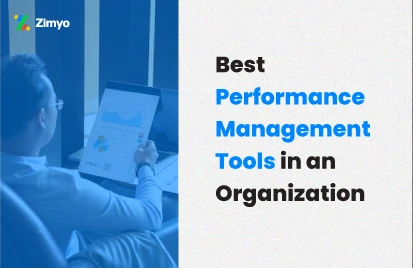OKR software helps in building a specific OKR framework within the organization. An OKR framework helps in establishing, communicating & monitoring goals and objectives in a company. Establishing optimal objectives is a crucial factor for a company to progress.
With the evolving work culture and hybrid taking over, a growing number of organizations are turning to OKR software, the best tool for managing the progressively popular ‘Objectives and Key Results’ goal-setting framework.
Organizations have implemented OKRs to help maintain a structured alignment, allowing a flexible nature while execution. It’s a goal setting framework ideal for all types of workforces.
And while a company is on its journey to success, keeping track of the progress that has been made on the journey can help a company pave its way to the top.
The OKR software was designed by Andy Grove for companies to ensure that the whole company is contributing to achieving a single goal or a plethora of goals. But for this, the goal setting needs to be completed with the utmost precision within an OKR framework.
The leaders need to establish the company’s objectives and goals. These goals could then be defined at the departmental level, where departmental goals could be established so that employees can contribute to achieving specific goals which are associated with the company’s bigger goal.
What are the steps for implementing an OKR Framework?
OKR framework is easy to implement once you get a proper knowledge about it and with rising number of Performance Management Software within the market, the difficulty becomes low when it comes to understanding a software. Below are a few steps that would help a company implement its OKRs;
✧ OKR framework setting
A company’s OKR should be properly documented in a transparent way to ensure synchronization. Even the upper level managers should be well aware about how to set team goals using an OKR Software. If the superiors of a company fail to clear all the confusion among the employees then it can cause problems in achieving OKRs.
OKRs need to be moderate, not too difficult, and not too easy. They need to be flexible, transparent, and measurable. While a company establishes, documents, and defines its OKRs, they need to take care of a lot of things.
✧ Review records & industrial trends
The previous records and accomplishments of employees need to be reviewed while establishing OKRs. An extremely demanding OKR framework would be demotivating while a simply achievable goal may not push the employees to give their best.
In the same manner, analyzing the industrial trends can help a company to determine what key responsibility areas (KRA) they need to focus on while setting the goals for their employees.
✧ Discuss
While a company might choose to set OKRs for their employees it’s also important to do so with the employee’s input to make it a fruitful feat.. It can also help to address the employee’s concerns and this, in turn, will help the company to reach its goals.
✧ Track the progress of established OKRs
Once a company is done setting its OKR framework, the next thing to do would be to ensure that all team members and employees stay on the same and right track. To do this, group meetings and discussions must be conducted to see how far everyone has progressed in achieving their goals.
Employees who are involved in groups might want to conduct a meeting every week, while some people might submit a report based on their progress fortnightly or weekly. Inter-departmental progress-related meetings can also be conducted quarterly or monthly.
Plus, even if a small part of a job is being carried out individually, conducting such group meetings or discussions might help to encourage and motivate employers to communicate and exchange each other’s knowledge. This can also help to create a positive company environment while helping everyone to achieve their goals in accordance with the OKR framework.
✧ Monitor the OKRs
It is extremely essential to monitor not only the progress of the tasks but also if its going in alignment with the set OKR framework. In today’s dynamic era, from economy and innovation, to customer preferences, everything is changing so rapidly.
This can become an issue for a company when achieving its OKRs. Moreover, many companies start business, and adopt this goal-setting software to progress their business. If a company ever notices that something in its OKR framework isn’t working or it needs some alterations, then the company must modify its OKRs.
✧ OKR & Performance Management
Most of the companies that have implemented OKR software into their company have become better at planning, prioritizing, and focusing by making the company’s priorities clear.
Implementing OKR software and a goal-setting framework has helped them to understand where they need to contribute more and what to skip if there is an action plan that needs to be changed or not, and to remain focused on its established goals.
Similarly, tracking their goals has helped many companies create a culture of accountability and measurement, which helps the company to remain on track by developing checkpoints.
Companies have also noticed a paradigm change where the employees not only complete the tasks given but also are concerned about the effect and cause of their actions. This change comes from a sense of flexibility, autonomy, and creativity among workers that is developed by the OKR framework.
This contributes to employees’ satisfaction and better results, in turn its an overall contribution toward the organizational goal achievement.
What are the key points to remember while implementing an OKR framework?
Following this OKR framework guide, you can easily implement OKR software in your company
- Create annual objectives & break these objectives into quarterly goals. This helps to create quarterly as well as long-term focus, and clarity.
- Establish top organizational goals first, this would help you to establish your top priorities. And everyone can also align and contribute to these goals.
- Establish the shared departmental, and team goals as it is important to establish shared objectives for a particular department, team, or group and not only an individual.
- Appoint a DRI for each OKR, as this can help to drive the progress of your OKR. DRI does not require to be the team manager, they could just perform as an owner or manager of the project or OKR.
Conclusion
An effectively set OKR framework is easy and efficient. From start-ups and small enterprises to big and supreme companies, everyone can progress their business and track their accomplishments by implementing an OKR software that companies like Zimyo offer to everyone to transform an organization’s performance management.
As the nature of work is changing, so is the type of work an employee does. Today’s workforce want both flexibility, structure, along with alignment and even autonomy. Expectations such as this might seem to be in tension, but setting an OKR framework can aid companies in finding harmony between the two.
However, one also needs to monitor the established OKRs to see if it’s working properly or not. If necessary, one should modify their OKR framework for better results. Following the above-mentioned OKR implementation steps one can easily keep track of all of these to avoid any delay or hindrance in achieving their company’s goals.
Also Read: OKR Tracking: Why is It Important and How to Do It?





